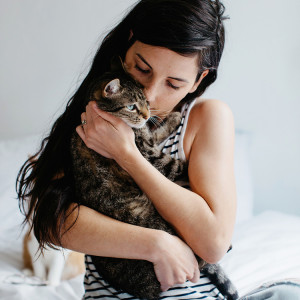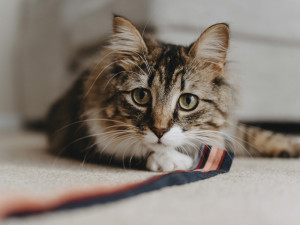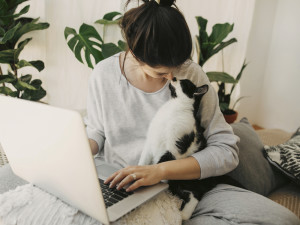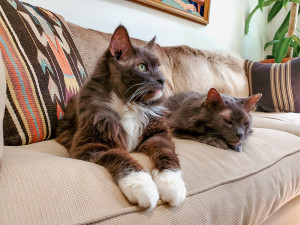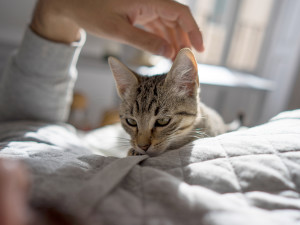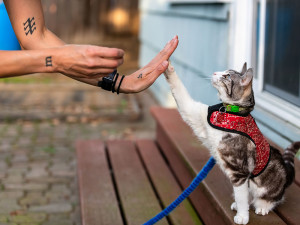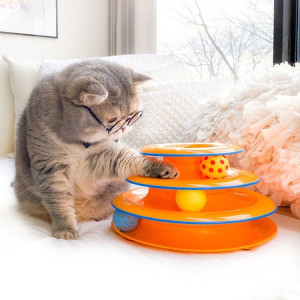What’s Your Cat’s Love Language?
Five surprising ways cats show affection (and how you can show it back), according to a cat behaviorist.

Share Article
It has long been a stereotype that cats are stingy with their love. But say that to a cat behaviorist, and they are likely to scold you for perpetuating that myth. Cats are individuals, and while some may prefer for you to leave them alone, others are quite the snuggle bugs. And we should all be experienced in life enough to know by now that affection is not the only way to show love. If it were, everyone in your life would be a hugger, and that would make social interactions a total nightmare.
When it comes to your cat, you just need to know how to love them. Here, we break down every way your cat shows you just how much they care about you.
How to identify when your cat is showing affection
Some signs of cat affection are obvious: rubbing up against you, purring, allowing you to stroke or hold them. But others can be a little trickier to understand, especially if you’re new to cats or have one who seems particularly aloof.
Once you know how your cat likes to show their love, you can use that information to show affection back (speak to them in their own language, as it were), which helps strengthen your bond.

How do cats tell their pet parents “I love you”?
There are a few ways to say “I love you” in cat. Below are some common signs of cat affection.
1. Slow blinking
According to LA-based feline behaviorist and Cat Counseloropens in new tab Cristin Tamburo Coll, a slow blink is a cat’s way of showing you that they trust you and feel safe with you — an essential component in any loving relationship.
“Intense staring with wide-open eyes can sometimes be a threatening gesture in cats and staredowns among cats often turn into fights,” she says. “But when a cat slow blinks at you, they are showing you that they feel calm and safe in your presence.” So, the next time your cat slow blinks at you, give ’em a slow blink back to let them know the feeling is mutual.
2. Putting their butts in your face
If you have multiple cats, you’ve probably seen them sniffing each other’s butts (just like dogs). But what you might not realize is that the sniff-ie is just as active in this exchange as the sniff-er. It’s one way for cats to say, “We’re cool.” Now, we’re not suggesting you stick your butt in your cat’s face, but if you want to give it a shot, it probably couldn’t hurt.
3. Showing you their bellies
But beware: This is not always an invitation to touch said cat belly. Some cats dig belly rub s, but many don’t and might bite, hiss, or scratch. “A cat’s belly is their most vulnerable spot,” says Tamburo, “so when they show it to you, they’re saying ‘I trust you,’ not necessarily ‘I want you to touch me.”
4. Being in the same room as you
Not all cats are cuddlers — but not being big on snuggles doesn’t mean they don’t like you. The fact that they don’t leave the room when you enter is proof that they do! If your cat is particularly aloof, try spending some time where they are. Read a book, watch TV, scroll on your phone — just let them see that you want to spend time in the same space.
5. Bringing you presents
Cats are hunters by nature and an outdoor cat will often bring their human dead rodents (or pieces of dead rodents) as tokens of affection. Indoor cats, on the other hand, might bring toys, pieces of string, or whatever else they find around the house.
Accept your cat’s gift in the spirit in which it was intended and give them a little treat, cuddle, or stroke to show your gratitude. Or play with them! Cats love play. Sometimes, it’s just a matter of figuring out exactly what gets them excited.
How can I make my cat love me?
The truth is, there’s no way to make an animal love you. Trust is built slowly over time. If you give your cat lots of love, they’ll come to love you back — even if all pets show that love in different ways. Give your cat lots of space and time, and never punish your cat.
Just as cats can slow blink to show you love, you can say “I love you” to a cat by slow blinking at them. Karen McComb, a professor who worked on a study on cat slow blinking for Scientific Reports, recommends: “Try narrowing your eyes at them as you would in a relaxed smile, followed by closing your eyes for a couple of seconds. You’ll find they respond in the same way themselves and you can start a sort of conversation.”
Are treats and rewards effective as a love language for cats?
If you’re wondering if you can buy your cat’s love with treats and rewards — well, it’s worth a try. Cats love being mentally stimulated, so try incorporating treats and rewards into playtime and training for your cat. And keep an eye on the amount of treats you feed them, because a healthy cat is a happy cat.
FAQs
How can I show affection using physical touch as a love language?
Petting a cat can be a great way to bond, but be sure to follow their cue on whether they want to be pet. Check out our guide on cat-petting lessons.
Can a cat have more than one love language?
Like humans, cats can definitely have more than one love language. Plenty of cats show love in a variety of ways.
What if my cat doesn’t seem to respond to any particular love language?
If your cat doesn’t seem to respond to any particular love language, have patience. Cats aren’t always the most expressive and may show their appreciation with subtle cues. If they aren’t resisting your affection by hissing, leaving, or taking out their claws, they might be happier than you think.
What does it mean if my cat values a safe environment as their love language?
All cats should have a safe and quiet environment, and providing them with a cozy home is one way you can show your love. Make sure they have a calm space all to themselves, especially for eating and using the litter.
How do I know if my cat’s love language is quality time?
If your cat’s love language is quality time, they will spend a lot of time near you or in the same room as you.

Charles Manning
Charles Manning is an actor and writer based in New York City. In his free time he likes to cook, go swimming at the public pool, volunteer at the LGBTQ senior center, and foster senior and special-needs cats. His work has previously appeared in Cosmopolitan, Elle, Marie Claire, Harper’s Bazaar, Seventeen, and Nylon.
Related articles
![Two senior cats laying on a couch]()
Why Senior Cats Make the Best Roommates
Kitten, please! I adopted a couple of seniors because cats, like wine, only get better with age.
![kitten sleeping on top of person]()
Why Does Your Cat Sleep on You? 7 Reasons and What It Means
Not into cuddling? Too bad—they’re spending the night.
![Training a cat sitting with leash and harness on.]()
A Step by Step Guide on How to Clicker Train Your Cat
This popular training technique isn’t just for dogs. Here’s how you can use it for your cat.
![Gray and white cat walking out the door]()
Preventing Escape Artists: How to Keep Your Cat from Running Away
Your kitty’s an explorer. Just keep their expeditions indoors.
![Cat playing with orange puzzle toy]()
The 5 Best Interactive Cat Toys By Nina Ottosson
The puzzle toys that’ll unleash your cat’s inner cougar.

